| Author | Message | ||
Dsergison 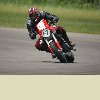 |
oh this has really gotten me crossed up. I am struggling to get my mind around the physics of it all. or to toss out what everyone "thinks". Something is wrong with one or the other ideas.... anyway here we go: why does everybody say the torque is just as important, more important, etc... it's like electricity right, v*a=w rpm*tq=hp hp = watts = work done. comparing two different units is useless. a bike with more horsepower can do more work. period. if it isn't pulling you arms out of the sockets hard enough youre in the wrong gear. since bikes come with transmissions that cover the usable speed ranges I just can't understand why people are all on this torque craze. i love my bike but I cannot pass on excuses about how it is like a 130 horse bike because of all the torque. that seems boloney. IDK, Dan | ||
Stealthxb 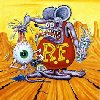 |
Ah naw, hell no man ya'll done upped and done it! | ||
Reepicheep 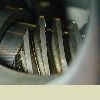 |
Everyone (well, most people) says torque is more important because (bracing for impact) they are wrong. You are dead on. HP == watts (literally). That is the only number that matters. Now that I have cleared that up nicely, let me muddle the waters again. As wrong as people are about the whole torque thing... they are actually right. They call this thing "torque", but they are actually describing something else. What they are actually describing is a curve of horsepower versus RPM. At the speed the average squid on a 600cc repli-racer spends most of their time, they are riding a 40 HP scoot, if that much. The "HP" ratings are all peak, which is just about useless. All it measures is what you bike is doing at the moment you can no longer do it (i.e. redline). What they *should* do is discuss the overall curve of horsepower versus RPM, as this is what gets translated to your street riding experience. Take two machines, making equal peak horsepower, but one through high torque and the other through RPM's. The HP versus RPM curve of the high torque bike will be MUCH flatter between crusing speed and redline. You could do about the same thing by getting one of the 13,000 rpm hyper 600's, and just setting the idle at 6,000 RPM. The horsepower versus RPM curve then would look much like the torqe heavy motor, but trying to ride the bike with a 6000 RPM idle would be annoying as hell. So while "watts is watts", peak horsepower does not matter, the area under the HP versus RPM curve is what matters most, with the nature of that curve coming in a close second. Peak horsepower is arguably just as useless a number as the mythical "torque" figure. | ||
Ezblast 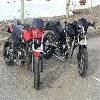 |
Popcorns out, cigar is lit, and wiskey poured - ready to watch - Let the 'Education' begin! GT - JBOTDS! EZ  | ||
Fdl3 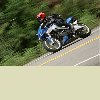 |
Reepicheep: Good reply! | ||
Signguyxb12 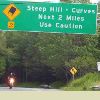 |
If you compared a motor's area under the curve to another moter's area under the curve .... wouldn't that be the best way to tell which would be a "better" ride on the street ??????????????????????? and could that number be expressed some how so the average person could make a fair judgement | ||
Dsergison  |
"If you compared a motor's area under the curve to another moter's area under the curve .... " that would require Calculus, ouch. OK. I thought so. thanks reepicheep for the very lucid relation. I've over looked things before and I hate it when I need to restructure my world view because I have entreanched myself too strongly in something incorrect. I guess i just needed to hear it from someone else. | ||
Reepicheep  |
No need for calculus, just plot the curve, take a highlighter and draw a box around the RPM range at which the bike won't annoy the hell out of you to ride, and just look at that. This still won't make the Buells a miracle bike, but it does put things in perspective. Lay the power curve for a nicely tuned 1200cc Buell engine on top of the hyperbikes, and it is pretty close. The Buell just stops at a particular RPM while the others others keep climbing. If you are not above this "magic RPM", there is *absolutely* *no* *discernable* *difference* in power output of the bikes!!!!! So people sing the praises (rightfully) of the low end grunt of bikes like the FZ1, the TL-1000 / VStrom, the Bandit 1200, the GSXR-1000, even the 'Busa. In fact people choose these bikes over others exactly because they have a broader powerband. But if you look at how non racers actually ride these bikes, 99.9% of their riding time (literally) is spent solidly in the middle of that low end part of the curve. So what is my Buell? 99.9% of the time it is just as powerful as Dyna's R1, and 100% of the time better looking  | ||
M1combat 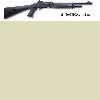 |
"If you compared a motor's area under the curve to another moter's area under the curve .... wouldn't that be the best way to tell which would be a "better" ride on the street ??????????????????????? " No. You have to go through all the RPM's from idle to where you are "on step" or "on the pipe" or "in the power band" or whatever you want to call it each time you leave a light (or a corner incedently). The only way to get a ~100HP launch out of a high revving 600 is to slip the clutch "just right" until the RPM and wheel speed match. On a bike with a "good" torque curve, the power is there earlier. In any case... It's not exactly "the area under the curve" thats important... It's "the USED area under the curve" that's important. Only figure the area under the part of the curve that you will be using (except when you launch - Anyone notice that the FX Buells tend to leap forward 5-6 places at the start of the races?). I think when people say that "torque" is better, what they really mean to say is that a torquey engine is better (FOR THEIR TASTES AND APPLICATION). Personally... I'm completely convinced that a torquey engine is FAR better for the street than a high revving RPM engine. The other thing you need to remember is that there is a human factor in racing. Less shifting is ALWAYS better than more shifting given everything else is the same. | ||
Ftd 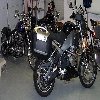 |
"Personally... I'm completely convinced that a torquey engine is FAR better for the street than a high revving RPM engine. " Sums up exactly why I am hoping for a CityX12 next model year! Frank | ||
Aldaytona  |
Simply put, TORQUE is the force that effects acceleration. HORSEPOWER is the force that effects top speed. | ||
Lakepipe |
Spot on!TQ = thrust HP=Speed now this is they way i explaine it, looking at the TQ tells me what size the horses are. Lakes | ||
Buells Rule! (Dyna in disguise) 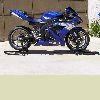 |
So what is my Buell? 99.9% of the time it is just as powerful as Dyna's R1, and 100% of the time better looking Merry Christmas to you too  | ||
Aaron |
"Simply put, TORQUE is the force that effects acceleration. HORSEPOWER is the force that effects top speed." "TQ = thrust HP=Speed" Wrong on both counts. Torque is angular force, rpm is speed. Horsepower is the combination of torque and rpm. It's literally torque times rpm. Torque and rpm make equal contributions to horsepower, and in fact they're totally interchangeable, just gear it differently. You want more torque? Gear shorter. Torque will go up and rpm will go down by equal factors. You want more rpm? Gear taller. Rpm will go up and torque will go down by equal factors. Horsepower remains the same in all cases, because the product of the torque and rpm remain the same. Every time you upshift, you give up rear wheel torque and gain rear wheel rpm. That's why you can pull wheelies easier in 1st than in 5th. If torque is what matters, why do you ever take your bike out of first gear? Or could it be that speed matters too? Or more specifically, how much torque you can make at a given speed? That number is called horsepower. Fact: At any given rear wheel speed, the bike with the most horsepower also has the most torque at the rear wheel. Always. (Message edited by aaron on December 17, 2004) | ||
Rockbiter1 |
Torque*rpm/5252=HP....HP is a dirivitive of torque and rpm, divided by the magic number of 5252. (from how an HP was originally calulated, long and involved discription) Of you make 60ft lbs of torque at 2500 rpm, you have 28.6 hp if you have 80 ft lbs of torque at 6000, you have 91.4 hp. HP is nothing more than a descriptive quantifier of torque vs rpm. | ||
Newblaster 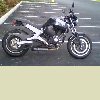 |
You know, I was hoping for a more lively discussion when I saw this thread. Now my popcorn is going to waste. Can someone start a "contact patch" discussion? | ||
Aldaytona  |
CRAP, just broke my calculator when I dropped my slide rule on it because I tripped on a contact patch while thinking about fresh popcorn. | ||
Crusty |
If you're riding on a concrete highway, would the portion of the road directly under your tires be known as Contact Cement? Is that kind of a sticky question? | ||
M1combat  |
Why yes... As a matter of fact it would. I think it would be an oppositorqueslab too... | ||
Ted  |
http://www.bgsoflex.com/roughhp.html Engine Displacement (CC) is 16125.1 (984) Mean Compression ratio is 10.0 Engine Revolutions Per Minute is 7000 Computation Results: Computed Engine HP is 77 neato. | ||
Rick_a 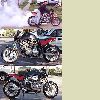 |
Yeah man, youse guys totally ruined it for me. It comes down to feel. A friend of mine recently described the difference in what I can best describe as character between his 90-some horsepower Buell and a 90-some horse inline 4 he test rode. I can tell you that 60ft-lbs at 2500 RPM is a lot of fun. My brother said it best when comparing my Buell to his VFR800...he said it feels like when his bike is in the torquiest range of the powerband...only it's there all the time. | ||
Rick_a  |
Anyway...if anything it's less work for your left foot... (Message edited by rick_a on December 17, 2004) | ||
Mbsween 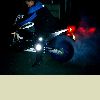 |
Can we talk about momentum? polar moments of inertia? Prandle number? Mach number? Boundry layers? laminar flow?...... Awww crap we could be riding instead of going to Physics class Aaron's got it nailed. HP is a man made term to describe a transient quantity, power, which in this case is the product of rpm and torque divided by a constant. So remember , you measure torque and rpm, you derive horsepower from those numbers And the pesky 5252? Note horsepower units are ft-lbs/sec, torque is ft-lbs, and rpm is rev/minute. The 5252 comes from converting revolutions to radians, we really need to go back to physics/calc classes to explain that one Moral of the story make as much torque as you can across all pm the motor runs at. It aint easy to do, just ask Aaron :} Maybe we should switch to turbines, they don't have the torque drop off that a piston engine has with rpm. Of course 1000+ degree exhaust temps might pose a new set of problems ... Sorry for melting the front end of your cruiser officer..... | ||
Ray_maines 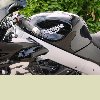 |
The Reepster sez: If you are not above this "magic RPM", there is *absolutely* *no* *discernable* *difference* in power output of the bikes!!!!! I disagree just a little teeny tiny bit. Everything else being equal (torque, HP, RPM, road speed, gears, whatever else you can think of) a V-Twin will feel (and sound) different to the rider than an I-Four. Whether or not it's "Better" is purely subjective, but it's discernible. | ||
Buells Rule! (Dyna in disguise)  |
it's less work for your left foot... Oh really now? You know, I was hoping for a more lively discussion when I saw this thread. Jump in then & lets see if you agree with the above statement. | ||
Newblaster  |
As to agreeing... Well... Never having ridden an inline 4, I have no idea. I would assume, however, (knowing very well what happens when we ASSume) that keeping a bike in the fat part of the curve is more work on any bike with a (relatively) narrow powerband, regardless of engine type. From the sheets and numbers I've seen, I would say that a twin (any twin) has a much more broad range than most inline 4s. Just a guess, as I said, but a somewhat informed one, I think... | ||
U4euh |
Old drag racing buddy tells me that Torque can be equated to the glutius maximus factor. How hard will this thing pull? RPM can be equated to, top end and how fast it gets there. Don't know the physics or the or even if it is true, but my butt tells me that my Buell has more torque than my 1100f, where as the 1100f is faster in the respect of getting to top end and the speed of top end.  On any given day I'd take the Buell, unless somebody is talking s--t, then bring the 11 out and spank'em on the 1/4. | ||
M1combat  |
Torque Multiplication is the real factor. It's what Aaron was getting at with the rear wheel torque and RPM. (Message edited by m1combat on December 17, 2004) | ||
Blake |
This may blow some minds... You have a jet engine rated at 400 LBs peak thrust. How much HP does it produce? | ||
Blake |
Someone said that we measure torque and RPM in order to determine RWHP. On a Dynojet or any other inertial dynamometer, how is torque measured? Answer... It isn't. To determine RWHP, only one measurement taken by the dynamometer is needed, drum speed versus time (drum acceleration). To determine engine torque referenced to the rear wheel (not at the rear wheel), one more measurement is needed... engine speed. There are dynamometers that will measure torque at the rear wheel to determine HP. Those are known as brake dynomomters. Some dynomometers, like the Dynojet model 250 offer both types of HP measurement, inertial and brake. Which one would you want to use for a drag bike? Which one might be better for a land speed bike? This is fun stuff.  |